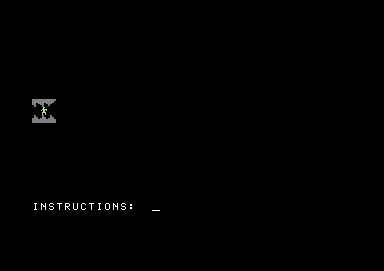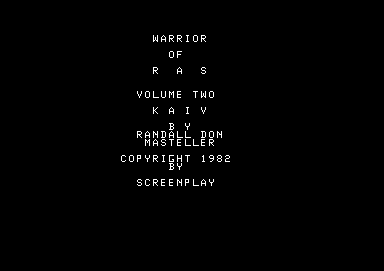Retro Replay Review
Gameplay
Kaiv offers a deeply strategic experience by combining classic turn-based dungeon crawling with text‐command input. Rather than moving a character directly with a joystick or mouse, you type commands like “MOVE NORTH,” “LIGHT TORCH,” or abbreviations such as “MN” or “LT” to navigate twisting corridors and dimly lit chambers. You can even accelerate exploration by issuing “MOVE EAST 3” to cover multiple tiles in one go, while the handy “SPEED” command rushes through descriptive messages for experienced players.
Encounters in Kaiv are fraught with peril. Acid pools, slime‐slick floors, and dispersed pit traps can bring sudden death if you aren’t paying attention or fail a quick‐reaction key prompt. Thieves dart through the halls snatching your hard‐earned gold, and random teleports can instantly whisk you away from safety. On top of environmental hazards, twenty‐four unique monsters—including shambling Zombies, fierce Dwarves, and winged Vampires—test your tactics and resource management.
Combat in Kaiv is a standout feature that elevates the Warriors of Ras series above many contemporary roguelikes. Both you and your foes have separate hit points and armor values for each body part. Targeting a creature’s head or torso requires different chances to hit and can be enhanced by prefacing your attack with “AIM,” which slows time for precision, or “FORCE,” which boosts damage at the cost of accuracy. This layered system encourages experimentation and careful observation to discover each monster’s weak spots.
Building on its predecessor Dunzhin, Kaiv adds a shop at the dungeon entrance where you can stock up on essential gear, from torches to holy crosses and reflective mirrors against vampires and gorgons. Magical items like rings, wands, and potions further diversify your strategy, enhancing your defenses or boosting offensive prowess. You must also plan for basic needs—carrying enough food and drink to stave off hunger and thirst becomes as vital as choosing the right weapon. Thankfully, Kaiv’s generous save system means you can pause and resume your descent at any time.
Graphics
Kaiv’s visuals reflect its roots in early graphical roguelikes, featuring simple but effective tile-based graphics. Each dungeon floor is rendered in a limited color palette that conveys walls, floors, and doors with clear, pixelated icons. While basic by modern standards, the minimalist aesthetic ensures readability and supports quick decision‐making during tense exploration.
Monster sprites are distinct despite their small size, allowing you to distinguish a creeping Slime from a charging Wyvern at a glance. The interface reserves a separate panel for status messages and combat feedback, keeping the main play area uncluttered. Text prompts and notifications appear instantly, with the optional “SPEED” command speeding through repetitive lines for veterans.
Lighting effects, though rudimentary, play a crucial role in atmosphere and gameplay. Torches cast a small radius of visibility, and stepping into darkness feels genuinely risky. Even with its low‐resolution presentation, Kaiv captures the suspense of delving into an unknown labyrinth, proving that imagination often fills the gaps left by primitive graphics.
Overall, the graphical style may seem dated now, but it remains functional and charming. For retro enthusiasts, Kaiv’s visuals evoke a nostalgia for a time when gameplay depth mattered more than polygon counts. The clarity of each tile and icon ensures that you’ll spend less time deciphering the screen and more time planning your next move.
Story
Kaiv’s narrative is straightforward: you are an intrepid adventurer entering the mythical dungeon Kaiv to slay monsters and amass treasure. There’s no sprawling lore or branching dialogues—just the primal thrill of risk versus reward. This simplicity keeps the focus squarely on exploration, survival, and tactical combat.
Although the story doesn’t unfold through cutscenes or elaborate text passages, environmental details hint at the dungeon’s history. Crumbling statues, scattered bones, and ancient graffiti messages encourage you to piece together what befell previous explorers. Each descent feels like stepping into a living museum of past failures, driving home the high‐stakes nature of the adventure.
The game’s minimal narrative framework serves its roguelike design perfectly. Without extended storytelling segments, every action—from deciding when to rest and heal to choosing which monsters to engage—carries significant weight. Your own emergent experiences, narrowly escaping a vampire’s fang or outwitting a cunning thief, become the true story, personalized to each playthrough.
Kaiv may lack the emotional arcs of modern RPGs, but its simple premise provides a blank canvas for your own tales of heroism or tragic demise. For players who relish forging their own narratives through gameplay, Kaiv’s stripped‐down story is its greatest strength.
Overall Experience
Kaiv stands as a testament to the depth that can be achieved with modest technology and clever design. Its turn‐based text command system demands patience and planning, rewarding careful players with the satisfaction of outsmarting deadly traps and fearsome beasts. The segmented hit‐point combat adds a layer of tactical nuance rarely seen in roguelikes of its era.
The difficulty curve is steep, especially for newcomers. Early characters can perish from a single unlucky hit or by stepping on a concealed trap. However, Kaiv’s anytime‐save feature offers a welcome safety net, allowing you to learn from each death and steadily improve. The inclusion of a shop and varied item pool provides strategic choices before each dive, ensuring your decisions feel meaningful.
While the graphics and storytelling are deliberately minimalist, they support the core gameplay rather than distract from it. For retro gaming enthusiasts, Kaiv delivers a powerful dose of nostalgia. For fans of tactical roguelikes, it offers a robust challenge that can consume hours of your time.
In summary, Kaiv is not for the faint‐hearted, but its addictive depth and old‐school charm make it a must‐try for players seeking a true dungeon‐crawling test of skill. If you appreciate methodical gameplay, punishing difficulty, and the satisfaction of a well‐earned victory, Kaiv will reward your perseverance with countless tales of triumph—and defeat—in its labyrinthine depths.
 Retro Replay Retro Replay gaming reviews, news, emulation, geek stuff and more!
Retro Replay Retro Replay gaming reviews, news, emulation, geek stuff and more!









Reviews
There are no reviews yet.